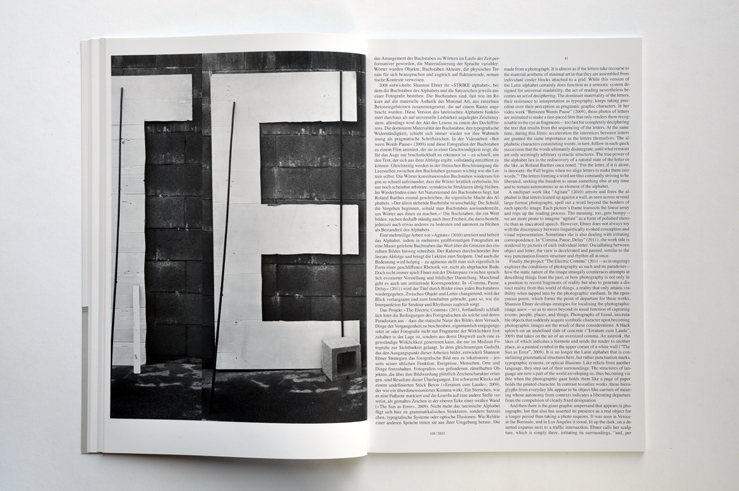Camera Austria International
118 | 2012
- JENS ASTHOFF
Natalie Czech: Readings of Images - NATALIE CZECH
- BARRY SCHWABSKY
Natalie Czech: A Lover's Discourse - KENNETH GOLDSMITH
Erica Baum: Closed Captions - ERICA BAUM
- VANESSA JOAN MÜLLER
Shannon Ebner: Non-Verbal Residuals - SHANNON EBNER
- SUSANNE HOLSCHBACH
Sven Johne: The Illusion of Eternal Summer
- SVEN JOHNE
- JAN VERWOERT
Image as Witness 2/4 How to Go About the Haunting?

Preface
Camera Austria International 118 | 2012
Preface
Entries
Forum
Vorgestellt von Mia Jankowicz und Constanze Wicke:
AHMED KAMEL
MOHAMED EZZ
IMAN ISSA
TAREK HEFNY
OSAMA DAWOD
MOHAMED ABDELKARIM
JASMINA METWALY
Exhibitions
Revolution vs Revolution
Beirut Art Center
WALID SADEK
Occupy! The Struggle for Free Spaces since the 1970s
Wien Museum, Vienna
MARINA GRZINIC / DANILA MAYER
Sofie Thorsen: Schnitt A-A’ / Cut A–A’
Kunsthaus Graz
Kunsthaus Baselland, Muttenz/Basel
MARGIT NEUHOLD
Thomas Ruff
Haus der Kunst, München
EVA MARIA STADLER
Making History
RAY 2012 Fotografieprojekte
MMK Museum für Moderne Kunst, MMK Zollamt,
Frankfurter Kunstverein, Frankfurt am Main
VERENA KUNI
Zwischen Neuerung und Restauration. Zum 50. Jubiläum des Oberhausener Manifests bei den diesjährigen Internationalen Kurzfilmtagen
58. Internationale Kurzflmtage Oberhausen
RAINER BELLENBAUM
Chantal Akerman: Too Far, Too Close
MHKA, Antwerp
YOANN VAN PARYS
Hans Haacke: Castillos en el aire / Castles in the air
Museo National Centro de Arte Reina Sofia, Madrid
MARCELO EXPÓSITO
Zoe Leonard: Observation Point
Camden Arts Centre, London
PAOLO MAGAGNOLI
Luigi Ghirri: Project Prints. An Adventure in Thinking and Looking
Castello di Rivoli
GABRIELE FRANCESCO SASSONE
John Gossage: The Thirty-Two Inch Ruler / Map of Babylon
Sprengel Museum Hannover
CAROLIN FÖRSTER
Boris Mikhailov: Time Is out of Joint. Fotografien 1966-2011
Berlinische Galerie, Berlin
JULIA GWENDOLYN SCHNEIDER
Ursula Biemann: Mission Reports
Lentos Kunstmuseum, Linz
MAREN RICHTER
What Is Left of Avant-Garde Performance Art – And Who Owns It …?
Gina Pane. E per amore vostro: l’altro
MART, Rovereto
STEFANIE SEIBOLD
La Triennale – Intense Proximity
Palais de Tokyo and various venues
ESTELLE BLASCHKE
Hito Steyerl, Thomas Keenan & Eyal Weizman, Paulo Tavares: Mengeles Schädel. Der Aufstieg der forensischen Ästhetik
Portikus, Frankfurt
MAREN LÜBBKE-TIDOW
Josephine Pryde: Miss Austen Enjoys Photography
Kunstverein für die Rheinlande und Westfalen, Düsseldorf
MELANIE OHNEMUS
Books
Erik van der Weijde: Palm Tree, 2009, Der Baum, 2010 und Bonsai, 2011.
4478zine, Amsterdam
JAN WENZEL
Michael Schmidt: Lebensmittel
Snoeck Verlag, Köln 2012.
JOACHIM BROHM
Gyula Halász Brassaï: Proust und die Liebe zur Photographie.
Suhrkamp Verlag, Frankfurt am Main 2001.
Kentaro Kawashima: Autobiographie und Photographie nach 1900. Proust, Benjamin, Brinkmann, Barthes, Sebald.
Transcript Lettre, Bielefeld 2011.
Anne-Kathrin Hillenbach: Literatur und Fotografie. Analysen eines intermedialen Verhältnisses.
Transcript Lettre, Bielefeld 2012.
GISLIND NABAKOWSKI
Imprint
Publisher: Reinhard Braun
Owner: Verein CAMERA AUSTRIA. Labor für Fotografie und Theorie
Lendkai 1, 8020 Graz, Österreich
Editor-in-chief: Maren Lübbke-Tidow (V.i.S.d.P.)
Editors: Margit Neuhold, Rebecca Wilton
Translators: Dawn Michelle d’Atri, John Doherty, Steven Lindberg, Wilfried Prantner
German proofreading: Daniela Billner
English proofreading: Dawn Michelle d’Atri
Dank / Acknowledgments:
Mohamed Abdelkarim, Jens Asthoff, Erica Baum, Kirsty Bell, Natalie Czech, Moyra Davey, Osama Davod, Florian Ebner, Shannon Ebner, Katja Eydel, Mohammed Ezz, Rike Frank, Peter Gorschlüter, Kenneth Goldsmith, Denhart von Harling, Tarek Hefny, Susanne Holschbach, Iman Issa, Mia Jankowicz, Ahmed Kamel, Sven Johne, Annette Kelm, Meike Kröncke, Markus Lüttgen, Robert Meijer, Jasmina Metwaly, Clara Meister, Vanessa Joan Müller, Barry Schwabsky, Adam Szymczyk, Ursula Teich, Jan Verwoert, Wallspace Gallery (New York), Thomas Weski, Constanze Wicke
Copyright © 2012
Alle Rechte vorbehalten. Nachdruck nur mit vorheriger Genehmigung des Verlags. / All rights reserved. No parts of this magazine may be reproduced without publisher’s permission.
Für übermittelte Manuskripte und Originalvorlagen wird keine Haftung übernommen. / Camera Austria International does not assume any responsibility for submitted texts and original materials.
ISBN 978-3-900508-02-9
ISSN 1015 1915
GTIN 4 19 23106 1600 5 00118





















